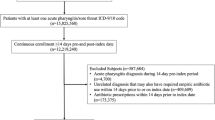Abstract
With the availability of group A beta-hemolytic streptococcal (GABHS) antigen detection tests, the management of adult pharyngitis is being reassessed. A decision analytic model was developed which considered four strategies: immediate treatment, no treatment, performing a rapid antigen test, or obtaining a bacterial culture. Patient outcomes were expressed in “well” days, which were reduced by the “sick” days associated with adverse reactions to treatment or complications of GABHS infection. When immediate test results are available, testing is the optimal strategy for probabilities of GABHS between 1 and 49 per cent. This range includes almost all patients, using probability estimates based on clinical criteria. The absolute benefit of testing was 0.1 days. The major advantage of a rapid test is the avoidance of penicillin reactions. Variations in the symptomatic benefits of treatment had minimal effects on the analysis. The analysis supports the use of an antigen test for adult patients with pharyngitis.
Similar content being viewed by others
References
Lowe R, Hedges JR. Early treatment of streptococcal pharyngitis. Ann Emerg Med 1984;13:440–8
Reilly BM. Practical strategies in outpatient medicine. Philadelphia: W. B. Saunders, 1984;71–100
Tompkins RK, Burnes DC, Cable WE. An analysis of the cost-effective-ness of pharyngitis management and acute rheumatic fever prevention. Ann Intern Med 1977;86:481–92
Land MA, Bisno AL. Acute rheumatic fever: a vanishing disease in suburbia. JAMA 1983;249:895–8
Infectious Disease and Immunization Committee, Canadian Paediatric Society. Rapid identification of group A beta-hemolytic streptococci in throat swabs. Can Med Assoc J 1986;134:228–9
Herman JM. Patients’ willingness to take risks in the management of pharyngitis. J Fam Pract 1984;6:767–72
Pauker SG, Kassirer JP. Decision analysis. N Engl J Med 1987;316:250–8
Centor RM, Witherspoon JM. Treating sore throats in the emergency room: the importance of followup in decision making. Med Decis Making 1982;2:463–9
Walsh BT, Bookheim WW, Johnson RC. Tompkins RK. Recognition of streptococcal pharyngitis in adults. Arch Intern Med 1975;135:1493–7
Centor RM, Dalton HP, Campbell MS, Lynch MR, Watlington AT, Garner BK: Rapid diagnosis of streptococcal pharyngitis in adult emergency room patients. J Gen Intern Med 1986;1:248–51
Centor RM, Meier FA, Dalton HP. Throat cultures and rapid tests for diagnosis of group A streptococcal pharyngitis. Ann Intern Med 1986;105:892–9
Siegel AC, Johnson EE, Stollerman GH. Controlled studies of streptococcal pharyngitis in a pediatric population. 1. Factors related to the attack rate of rheumatic fever. N Engl J Med 1961;265:559–66
Holmberg SD, Faich GA: Streptococcal pharyngitis and acute rheumatic fever in Rhode Island. JAMA 1983;250:2307–12
Bisno AL. The rise and fall of rheumatic fever. JAMA 1985;254:538–41
Sanford JP. Management of pharyngitis in an era of declining incidence of rheumatic fever: an overview and synthesis. In: Shulman ST, ed. Pharyngitis: management in an era of declining rheumatic fever. New York. Praeger, 1984:251–4
Feinstein AR, Wood HF, Spagnuolo M, et al.: Rheumatic fever in children and adolescents. A long-term epidemiologic study of subsequent prophylaxis, streptococcal infections, and clinical sequelae. VII. Cardiac changes and sequelae. Ann Intern Med 1964:60(suppl 5):87–123
Bennicke T, Brochner-Mortensen K, Kjaer E, Skadhange K, Trolle E. Penicillin therapy in acute tonsillitis, phlegmonous tonsillitus and ulcerative tonsillitis. Acta Med Scand 1951;139:253–74
Idsoe O, Guthe T, Willcox RR, et al: Nature and extent of penicillin side-reactions with particular reference to fatalities from anaphylactic shock. Bull WHO 1968;38:158–88
Denny FW, Wannamaker LW, Brink WR, Rammelkamp CH, Custer EA. Prevention of rheumatic fever: treatment of the preceding streptococci infection. JAMA 1950;143:151–3
Hedges JR, Lowe RA. Streptococcal pharyngitis in the emergency department: analysis of therapeutic strategies. Am J Emerg Med 1986;4:107–15
Nelson JD: The effect of penicillin therapy on the symptoms and signs of streptococcal pharyngitis. Pediatr Infect Dis 1984;3:10–3
Kellogg JA, Manzella JP. Detection of group A streptococci in the laboratory or physician’s office: culture vs antibody methods. JAMA 1986;255:2638–43
Hollenberg JP. Smltree 1.5, copyright 1986.
Kassirer JP, Pauker SG. The toss-up. N Engl J Med 1981;305:1467–8
Author information
Authors and Affiliations
Additional information
Received from the Division of General Medicine and Primary Care. Department of Internal Medicine, Medical College of Virginia, Virginia Commonwealth University, Richmond. Virginia.
A preliminary version of this work was presented at the seventh annual meeting of the Society for Medical Decision Making, October 21, 1985.
Rights and permissions
About this article
Cite this article
Hillner, B.E., Centor, R.M. What a difference a day makes. J Gen Intern Med 2, 244–250 (1987). https://doi.org/10.1007/BF02596449
Issue Date:
DOI: https://doi.org/10.1007/BF02596449




